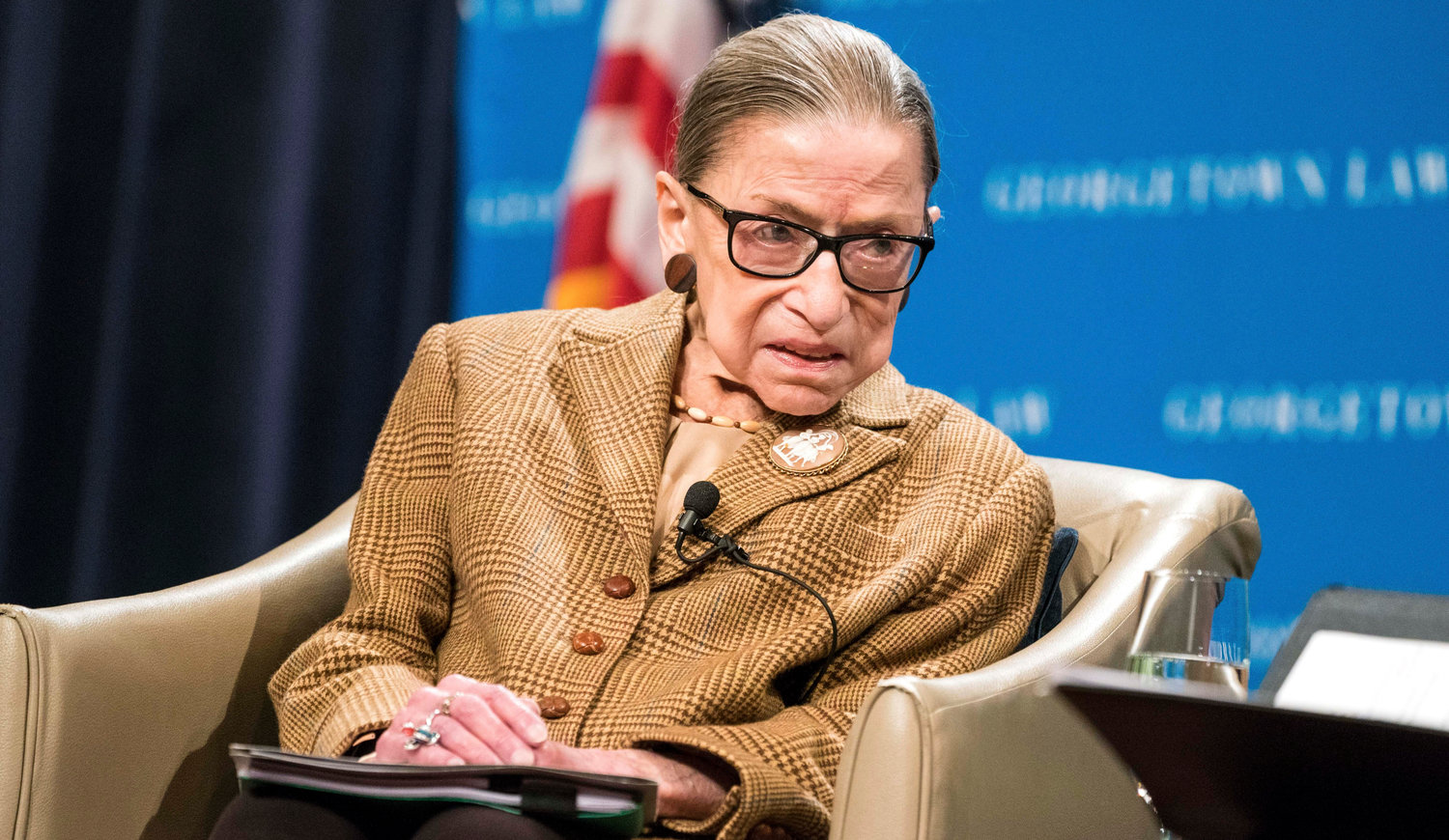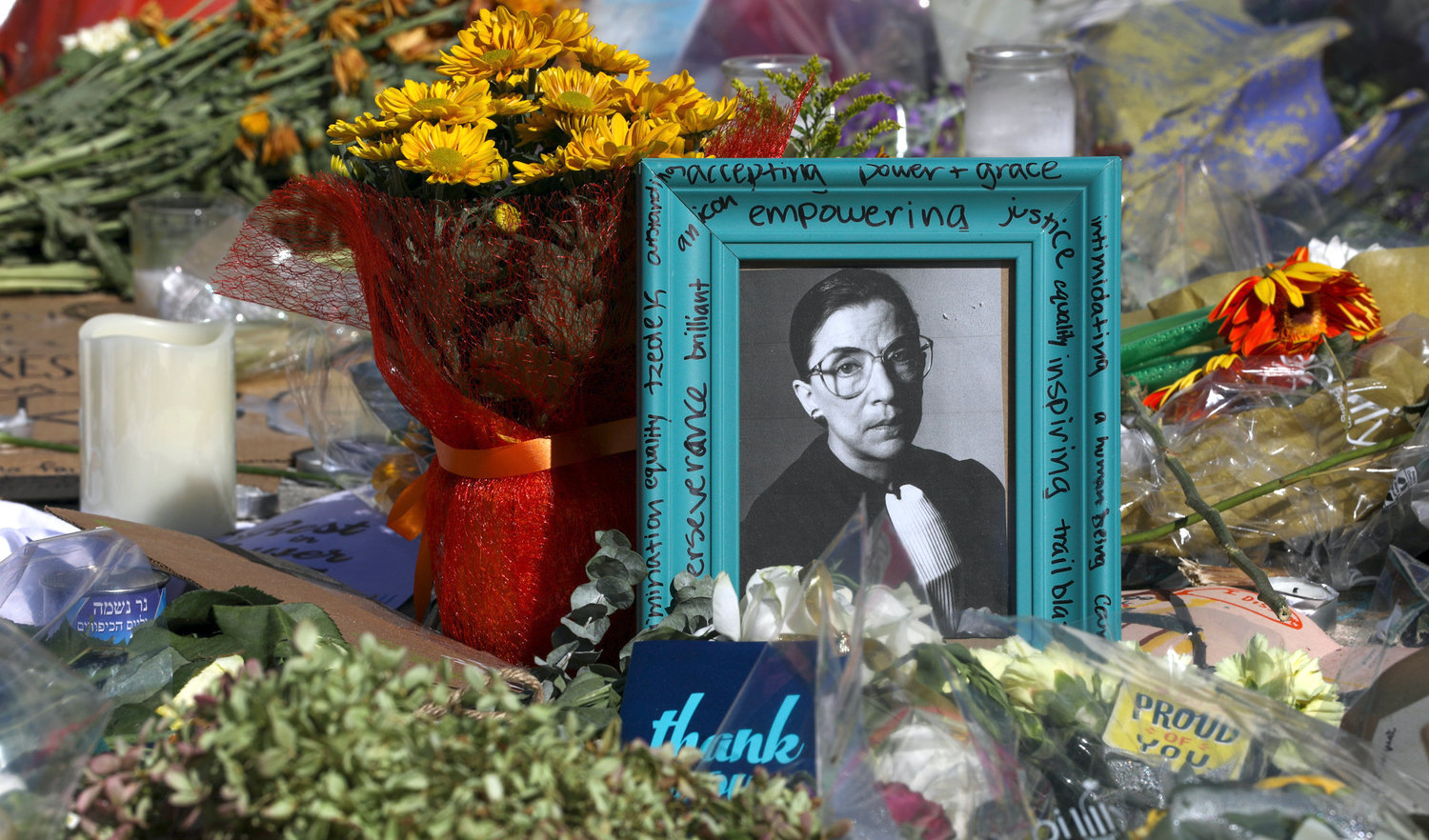Jews eulogize Ginsburg, who spoke often of her heritage
Ruth Bader Ginsburg, the first Jewish woman to serve on the US Supreme Court, died on erev Rosh Hashana, Friday Sept. 18, at the age of 87.
Ginsburg, a judicial, feminist and Jewish icon who was the second woman to serve on the nation’s highest court, died from “complications of metastatic pancreas cancer” at her home in Washington.
Ginsburg spoke often about the importance of Jewish tradition in influencing her life and career.
“I am a judge, born, raised and proud of being a Jew,” she said in an address to the American Jewish Committee following her 1993 appointment to the court. “The demand for justice runs through the entirety of Jewish history and Jewish tradition.”
In her Rose Garden nominating ceremony, President Bill Clinton Clinton lauded Ginsburg for standing with the “the outsider in society … telling them that they have a place in our legal system, by giving them a sense that the Constitution and the laws protect all the American people, not simply the powerful.”
Ginsburg attributed that outsider perspective to her Jewish roots, pointing often to her heritage as a building block of her perspective on the bench.
“Laws as protectors of the oppressed, the poor, the loner, is evident in the work of my Jewish predecessors on the Supreme Court,” she wrote in an essay for the AJC. “The Biblical command: ‘Justice, justice shalt thou pursue’ is a strand that ties them together.”
Jewish groups expressed condolences over Ginsburg’s death.
The Conference of Presidents of Major American Jewish Organizations said in a statement on Sunday, “We are deeply saddened by the passing of Supreme Court Justice Ruth Bader Ginsburg, who was in her own words ‘a judge, born, raised and proud of being a Jew’.”
“Justice Ginsburg, the first Jewish woman to serve on the high court, sought to apply the values of her faith in seeking equal justice under law and had a lifelong love for Israel,” continued the Jewish umbrella organization. “She is recognized as among the great jurists in modern history. She never ceased to advocate for gender equality while leading the way for women in the legal profession.”
B’nai B’rith said that Ginsburg was “a strong supporter of Israel and a lifelong Zionist [who] spoke of her inspiration from heroes like Emma Lazarus and Henrietta Szold.”
The Republican Jewish Coalition tweeted, “Justice Ruth Bader Ginsburg was a trailblazer and a great patriot. We, along with all Americans, mourn her passing. May her memory be a blessing.”
Jewish Democratic Council of America executive director Halie Soifer said that “Jewish Democrats mourn the enormous loss of Justice Ruth Bader Ginsburg, one of the most influential and powerful Jewish women to serve our nation. Justice Ginsberg embodied Jewish values including a commitment to tikkun olam, and our tradition’s commandment of ‘justice, justice, you shall pursue,’ which hung in her chambers in Hebrew.”
“All Americans owe her a profound debt of gratitude for her moral leadership, for the example she set as the first Jewish woman on the Supreme Court, and for her fierce advocacy of gender equality and justice for all,” said Democratic Majority for Israel.
Attorney Norm Eisen, a former US Ambassador to the Czech Republic, told JNS that Ginsburg was a Jewish icon who personified Jewish values.
“Justice Ginsburg exemplified a core Jewish principle — tzedek tzedek tirdof, justice, justice shall you pursue,” he said. “She understood it was not just a Jewish virtue but an American one.”
Attorney Nathan Lewin, who has argued in front of the Supreme Court, told JNS that Ginsburg “was a dynamic force in eliminating gender discrimination and will have a well-deserved place of honor in American legal history.”
Regarding what’s at stake for the Jewish community over the vacancy, “if you are speaking of the observant Jewish community and protection for religious rights, the future of that community and those rights is now bright,” said Lewin, emphasizing that Justices Clarence Thomas, Samuel Alito, Neil Gorsuch and Brett Kavanaugh “are strong defenders of religious liberty.”
• • •
The Brooklyn native was the daughter of Nathan Bader, a Russian immigrant and furrier, and the former Celia Amster. She often noted that her mother was “barely second generation,” having been born a scant four months after her parents’ arrival from Hungary.Ginsburg was keenly aware of the Jewish immigrant experience and her own good fortune to be born on these shores.
The Holocaust colored her perspective of the world and the law.
“Our nation learned from Hitler’s racism and, in time, embarked on a mission to end law-sanctioned discrimination in our own country,” Ginsburg said at a 2004 Yom Hashoah commemoration at the US Holocaust Memorial Museum in Washington.
“In the aftermath of World War II, in the civil rights movement of the 1950s and 1960s, in the burgeoning women’s rights movement of the 1970s, ‘We the People’ expanded to include all of humankind, to embrace all the people of this great nation. Our motto, E Pluribus Unum — of many one — signals our appreciation that we are the richer for the religious, ethnic and racial diversity of our citizens.”
But while Ginsburg was fortunate to be born in the United States, even brilliant women in the 1950s had no easy path. Following her graduation from Cornell University, where she met her husband, Martin Ginsburg, Ginsburg lived for two years in Oklahoma and experienced the setbacks that women faced at the time: She was demoted from her job at the Social Security Administration after her supervisor discovered she was three months pregnant.
Two years later, Ginsburg was one of only nine women in her Harvard Law School class with about 500 men. She had a 14-month old daughter and had to battle the endless skepticism of her professors and colleagues.
A well-known story has it that at a meeting of her female classmates with the law school dean, the women were asked why they deserved a spot taken from men.
When Martin, a Harvard Law graduate, took a job at a New York law firm, Ginsburg transferred to Columbia. At both schools she served on the Law Review, and she finished Columbia tied for first in her class. Yet not a single law firm would hire her.
Ginsburg eventually clerked for Judge Edward Palmieri and went on to teach law at Rutgers University. She created the Women’s Rights Project at the American Civil Liberties Union and was the first tenured woman to teach law at Columbia. Ginsburg quickly built a reputation for establishing gender parity before the law, arguing six major sex-discrimination cases before the US Supreme Court, winning all but one.
In one of those winning cases, Weinburger v. Wiesenfeld in 1975, Ginsburg represented a widower left with a child in his care when his wife died in childbirth. The father requested the childcare benefits that a woman would receive if her husband died but which were then denied to men.
“From the outset, she insisted that gender discrimination was not only an issue of women’s rights, demonstrating how using gender as a basis for different treatment was also harmful to men,” Judith Rosenbaum of the Jewish Women’s Archive said.
In 1980, President Jimmy Carter named Ginsburg to the US Court of Appeals for the District of Columbia. Her nomination to the Supreme Court was approved overwhelmingly by the Senate on Aug. 3, 1993.
She took her judicial oath of office a week later, becoming only the second woman to serve on the court after Sandra Day O’Connor.
As a Supreme Court jurist, Ginsburg continued her fight for gender equality.
In 1996, she wrote the majority opinion in United States v. Virginia, which deemed the Virginia Military Institute’s policy of not admitting women unconstitutional. She also authored the dissent in Ledbetter v. Goodyear Tire, a pay discrimination case that would lead to the 2009 Lily Ledbetter Fair Pay Act. Though a critic of the landmark Roe v. Wade case that decriminalized abortion nationally, Ginsburg consistently argued for protecting the right to abortion.
Late in her career, she emerged as a cultural icon. In 2013, law student Shana Knizhik started a Tumblr blog collecting all manner of Ginsburg fan art. The blog spawned a 2015 book with the Notorious R.B.G. tag co-authored with Irin Carmon.
Ginsburg is survived by two children — Jane, a law professor at Columbia, and James, a music producer — and four grandchildren. Martin Ginsburg died in 2010.
Kavod v’Nichum, a group that helps Jews engage with burial rituals, has organized a virtual version of shemirah, the practice of watching over a Jewish person’s body for the period between death and burial. Hundreds of people from across the United States — mostly women — have signed up to take on 30-minute virtual “watching” stints, during which participants are encouraged to read psalms and engage with readings related to death and grieving.
The virtual watch is set to extend far longer than is typical when Jews die, as Ginsburg’s funeral is being delayed so that she can lie in state at the US Capitol. She is the first woman and the first Jew ever to be afforded that national honor.

 47.0°,
Overcast
47.0°,
Overcast 







